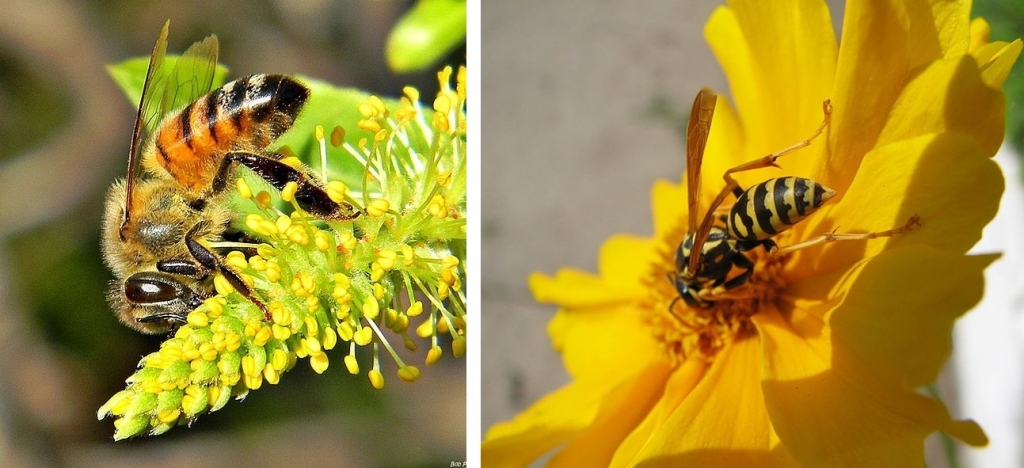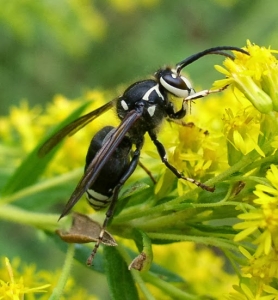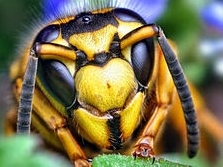When I headed out with the usual suspects that day for our usual lunchtime run, I didn’t expect to end up looking at a coworker’s naked buns, but that’s the way things worked out in the end. She was trotting down the Frog Pond trail twenty feet ahead of me when, all at once, she reached back and pulled down her running tights. As I was trying to figure out what to make of that move, she suddenly accelerated away from me, flying down the trail at an inspiring pace, and reaching back with her hand and slapping at one startlingly-white cheek. “Ow! Ow! Ow! Ow! Ow! Ow! Ow!” she said—though she repeated it more times than that. Finally she came to a stop and turned to face me, indignantly pulling her tights back up. “I got stung by a bee!” she said.
“It wasn’t a bee,” I said. “It was a yellow jacket.”
Sometimes being Ranger Randy can almost get you smacked.
* * * *
Well, the correction needed to be made, okay? Too many people in this world don’t know the difference between a honey bee and a yellow jacket and it’s my job to enlighten them at all the wrong moments. They are very different creatures. They are both yellow and black and they both sting, but there the similarity ends. A yellow jacket is not a bee, it’s a wasp, and by the way, you’re much more likely to get stung by one, and not just because their personality makes honey bees seem downright cuddly by comparison, but also because they don’t nest where bees do, way up in some tree cavity, conveniently out of the way. Nope, they nest in shallow burrows right underfoot, just beneath the forest duff. Walk too close to a nest, and one or two of them can get irate. Step on it, and they attack in force.

-
European Honey Bee (Apis mellifera) Yellow Jacket Wasp (Vespula vulgaris)
By Bob Peterson[CC BY-SA 2.0] By Audrey [CC BY 2.0]I have a relationship with yellow jackets (vespula vulgaris) that is just way more intimate than a cross-species relationship should be. I’d estimate that I’ve been stung by those things over two hundred times, though I don’t think I have ever been stung on the butt, and the principle reason for that is that I was always wearing heavy work pants, and the principle reason for that is that, well…um…I used to be a logger.
People are surprised when I tell them that, because I’m now such an unabashed tree-hugger and militant environmentalist, but I sort of got here the long way around, and when I yell and wave my arms at the public hearings in defense of our forests, I actually know whereof I speak—the truth is that I have slain a lot of trees, and I have seen the timber industry propaganda from its back side. I have a two-year degree in forestry, which is another word for logging, and I worked for two seasons in the woods before several things including the intellectual vacuum of small logging towns drove me on to other things. For one summer while I was in college, I worked on a crew doing something the Forest Service calls tree thinning. When you thin a stand of trees, you cut every small tree in about a twelve foot radius around the biggest and best looking one, to open up light and nutrients for the Chosen Ones so that they’ll shoot up and become lumber more quickly. It’s a god-like job, deciding who lives and who dies. You do this to an entire forest, finally leaving a bunch of perfectly-spaced trees sticking out of a five foot layer of slashed-up trunks and branches where the forest floor used to be. And of course, you’re only supposed to spare the commercially valuable timber species. So if, say, a tall, beautiful western black oak (Quercus kellogii) is within twelve feet of a pine seedling, you’re supposed to fell the oak. (Black oaks are beautiful trees, and I didn’t follow directions well at times.)
In the course of all this, you step on pretty much every square foot of every acre of that forest, or if you don’t you drop a tree on it, so if there’s a yellow jacket nest anywhere, you will get mixed up with it. And toward the fall, there are a lot of them. Several per acre. There are plenty of ways to get injured or killed when you spend your days surrounded by roaring chainsaws and falling trees, but this was by far the one that bedeviled us the most.
And I’ll tell you another difference between the two insects: When a honey bee stings you, she leaves her stinger and a handful of abdominal organs imbedded in your flesh, and then quickly dies. Yellow jackets don’t have barbed stingers, which means they can sting you repeatedly and fly away smiling and attack again tomorrow. One time one of them danced down the side of my face, stinging me five or six times in a crescent running from my right ear all the way across my upper lip. The little sucker got away clean, too, even though I risked life and limb by removing one hand from my chainsaw to slap at her. Another time I walked up to a crew mate, and he was standing thirty feet away from his chainsaw just looking at it, where it was sitting there on the forest floor. Puzzled, I looked at it with him, wondering what was up. Then I noticed that the saw seemed to be oddly in motion. Then I realized it was covered with yellow jackets. He’d set it down on a nest. He’d only gotten a couple of stings. They were attacking the saw. But that was going to have to change. We contemplated the thing.
“Well…you can’t just leave it there,” I said.
“I know…” he said. We looked at it some more.
“You gonna go get it?” I said.
“I thought you might.”
We looked at it some more. “I already have a saw,” I said.
“Mm-hmm,” he said.
Finally he let out a rebel yell and charged in at full flight speed, snagged the saw with one gloved hand without even slowing down and disappeared whooping and hollering into the woods. I stood looking after him. He didn’t quiet down for some time.
They have marauding personalities. They are inquisitive, opportunistic, tenacious and ravenous. When they check you out they have a sinister way of feinting back and forth just above your skin, like a boxer about to throw a punch. Even people who study wasps for a living call them “extraordinarily aggressive.” Almost every other wasp in the world is strictly predatory and hardly ever comes into contact with us, but yellow jackets are very unusual in that they have a scavenging behavior on board, and the sense of curiosity that always accompanies that, so they mix it up with human beings all the time. They get thick around picnic tables. Wave one away and she’ll immediately return. Swat her and she’ll get mad. They’re well-respected in the woods, both by us and other insects. Flys, moths, beetles and even other, non-stinging wasps mimic their markings protectively (it’s called Batesian mimicry), but the yellow jackets do have their own predators, including other wasps. We once hooted and cheered like kids as we watched a yellow jacket and a bald-faced hornet (Dolichovespula maculata), which is a larger, black and white wasp, roll around on the stump that was our lunch table, locked in a predatory battle to the death. The yellow jacket finally succumbed, and the bald-faced hornet flew away with her prize—right into a large, orb-shaped spider web twenty feet above us. Nature in action. A bad day for both of them.

-
Bald Faced Hornet (Dolichovespula maculata)
By Beatriz Moisset [GFDL]
Like bees, they have a potent venom but in a tiny quantity, and most people suffer no serious effects from a sting or three. But if you’re allergic or you get swarmed, you can quickly end up in anaphylaxic shock, which is a deadly condition in which your throat swells shut, among other things. Everyone who works in the woods is asked whether they have an allergy, but of course not everyone knows whether they do or not, and besides, allergies can come and go. There was a folk legend going around the Forest Service office I worked out of, about a foreman who was supervising a crew in the woods when a worker stepped where he shouldn’t have and picked up several stings. The foreman asked if he was okay. Yeah, the guy said. The foreman asked if he was sure. Yeah, no problem! he said. The foreman looked at him.
Later the foreman couldn’t explain why he did this, but he grabbed the guy, heaved him into the pickup and peeled out for town. By the time they got to the hospital he was comatose. He’d had his life saved by a man willing to trust his instincts.
Well, that’s the story on yellow jacket wasps, but it’s not the whole story. I wrote this article entirely from our perspective. In the next post, I’ll tell the tale through their eyes, and I’ll take you inside a nest, and introduce you to the queen.
Stay tuned.
Copyright © 2013 Randy Fry


Great article, as always!
This is timely as well…just a few weeks ago Roni, the dogs and I got swarmed on a hike when one of us stepped on a hive (most likely me). It was my first time getting swarmed; I picked up several dozen stings from head to toe and my ankles felt weird for about a week; Roni got several too, as did one dog. I was cussing and picking ’em out of my clothes for about a mile.
It’s interesting to me that they build hives in the ground; as one would expect, most flying species take advantage of not having to expose themselves to risks like getting flooded out or stepped on.